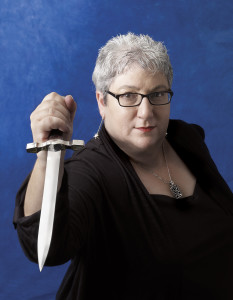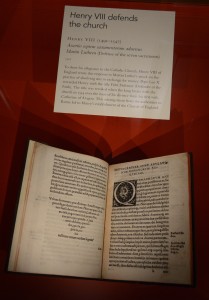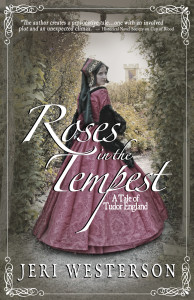 Relevant History welcomes back Los Angeles native and award-winning author Jeri Westerson. She writes the critically acclaimed Crispin Guest Medieval Noir mysteries, historical novels, paranormal novels, and GLBT mysteries. To date, her medieval mysteries have garnered twelve industry award nominations. The Historical Novel Society Review said of her latest historical novel Roses in the Tempest, “It is a wonderful, utterly involving performance—very strongly recommended.” Jeri is former president of the SoCal chapter of Mystery Writers of America and frequently guest lectures on medieval history at local colleges and museums. To learn about Jeri’s books and find discussion guides, videos, and more, check out her web site.
Relevant History welcomes back Los Angeles native and award-winning author Jeri Westerson. She writes the critically acclaimed Crispin Guest Medieval Noir mysteries, historical novels, paranormal novels, and GLBT mysteries. To date, her medieval mysteries have garnered twelve industry award nominations. The Historical Novel Society Review said of her latest historical novel Roses in the Tempest, “It is a wonderful, utterly involving performance—very strongly recommended.” Jeri is former president of the SoCal chapter of Mystery Writers of America and frequently guest lectures on medieval history at local colleges and museums. To learn about Jeri’s books and find discussion guides, videos, and more, check out her web site.
*****
I think whenever anyone hears the name “Tudor” we think of two things: Henry VIII and Anne Boleyn.
 Anne, Anne, Anne. I’m a little sick of her, but no one else seems to be. Why is she so important to the story of Henry VIII (who had four more wives after her)? And why is she important to my newly released novel of historical fiction Roses in the Tempest?
Anne, Anne, Anne. I’m a little sick of her, but no one else seems to be. Why is she so important to the story of Henry VIII (who had four more wives after her)? And why is she important to my newly released novel of historical fiction Roses in the Tempest?
Let’s back up a bit to Prince Arthur Tudor. He was the elder brother to Henry VIII, slated to be King Arthur. Way back in 1497 he was betrothed—by proxy—to one Katherine of Aragon of Spain. The reason it was by proxy was because he and his betrothed were too young, but a treaty between England and Spain was desired by monarchs of both countries and so the kids were connected early on. They even had a wedding by proxy because they didn’t meet until October of 1501 when it was deemed they were finally old enough to get married in the flesh.
The deed was done and not long thereafter, Arthur fell ill. In fact, he died short of his 16th birthday.
Now enter the young Henry. Suddenly, he’s heir to the throne. And elder King Henry didn’t want all that dowry money to go back to Spain so he insisted on young Henry marrying his sister-in-law. But when Henry turned 14 he said no!
In 1509 at the ripe old age of eighteen, Henry succeeded to the throne of England. And he looked at his accounting books and decided that thousands of pounds worth of dowry was probably a good thing to have when starting a reign, not to mention keeping the Spanish treaties intact. But this was his brother’s widow. Didn’t he need papal dispensation to marry her? It’s just a little bit incesty. But the pope said no problem. You only need a dispensation if the marriage was consummated, and Katherine swore devoutly that it was not. She and Arthur were 15 years old and married for twenty weeks but didn’t consummate their legal marriage. Well, there’s this bridge I’d like to sell you, too.
“There is no more lovely, friendly and charming a relationship, communion or company than a good marriage.” –Martin Luther, 1569
 Henry and Katherine were happy in the beginning. But it soon turned sour. She gave birth to a stillborn girl, then she gave birth to a boy, Henry, but he died after seven weeks. Then she gave birth to the Princess Mary (who was to become Queen Mary I, otherwise known as “Bloody Mary.”) During this time, Henry was catting around with all sorts of women. But he was also a devout Catholic. So much so that in 1521 he wrote his “Defense of the Seven Sacraments” a direct argument against the protestant reforms of Martin Luther. Pope Leo X named Henry “Defender of the Faith” for that bestseller.
Henry and Katherine were happy in the beginning. But it soon turned sour. She gave birth to a stillborn girl, then she gave birth to a boy, Henry, but he died after seven weeks. Then she gave birth to the Princess Mary (who was to become Queen Mary I, otherwise known as “Bloody Mary.”) During this time, Henry was catting around with all sorts of women. But he was also a devout Catholic. So much so that in 1521 he wrote his “Defense of the Seven Sacraments” a direct argument against the protestant reforms of Martin Luther. Pope Leo X named Henry “Defender of the Faith” for that bestseller.
But by 1525, Henry was getting impatient for a legitimate male heir and certain courtiers were beginning to whisper in his ear—courtiers like Cardinal Wolsey and his secretary the commoner Thomas Cromwell. Leviticus 20:21 says that “if a man shall take his brother’s wife it is an unclean thing: they shall be childless.” Though Henry was far from childless, he preferred to interpret the text to mean “sonless.” On this basis, Wolsey sought an annulment. The pope said nope.
Henry was getting all excited that this would work, that he could divorce his wife and marry—wait for it—Anne Boleyn, with whom he had been carrying on a chaste affair after having a not-so-chaste affair with Anne’s sister Mary (talk about incesty) who gave birth to yet another dead child. He got pretty pissed off with Wolsey, trumped up some charges, had him arrested, took over his just-finished manor house estate (that became Hampton Court) and was ready to put him on trial when he had the decency to die before that. Now Cromwell moved up and still had the king’s ear.
“The less prudent the prince the more his deeds oppress.” –Proverbs 28:16
Cromwell’s plan was to reform the Church, and since the pope wasn’t cooperating with Henry’s need for this divorce, why not break away from the Church of old and reform it into the Church of England? And who but the monarch was fit to rule that? Henry then gave himself a divorce, declared his daughter a bastard, and married Anne Boleyn, who, after all that, didn’t give him the son he wanted, but another princess, Elizabeth.
Henry’s taking over the province of the Church in England meant that he could get rid of all those corrupted and wealthy monasteries where all that expensive land was just sitting there when instead it could be sold and the revenue fill his coffers. And so that’s what he did. Cromwell was in charge of collecting officers with the cover story that they were inspecting the monasteries to root out corruption…but while they were there, they took an inventory of all the goods, too.
And that’s how Anne Boleyn becomes an intimate part of my story. The two main protagonists—Thomas Giffard, a knight of the court, and Isabella Launder the daughter of a yeoman farmer, who becomes a prioress in a tiny priory, two people that really did exist—are imminently affected by events at court. I thought it was a story seldom told, what happens when the rich and powerful make their decisions and how it trickles down the line. It makes my novel unique in that we get a glimpse of court and its machinations, but spend equal time down and dirty in the trenches. And though there are sad moments, it is not a sad tale. For because this is a true tale of real people, there is a dusting off of hands, a rising up, and stoically going on.
*****
 A big thanks to Jeri Westerson. She’ll give away a paperback or ebook copy of Roses in the Tempest to someone who contributes a comment on my blog this week. I’ll choose the winner from among those who comment by Friday at 6 p.m. ET. Delivery is available worldwide.
A big thanks to Jeri Westerson. She’ll give away a paperback or ebook copy of Roses in the Tempest to someone who contributes a comment on my blog this week. I’ll choose the winner from among those who comment by Friday at 6 p.m. ET. Delivery is available worldwide.
**********
Did you like what you read? Learn about downloads, discounts, and special offers from Relevant History authors and Suzanne Adair. Subscribe to Suzanne’s free newsletter.
